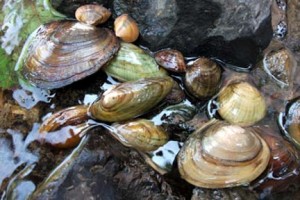Mussels have a bigger job than meets the eye. Listen up for the scoop on these clean water VIPs:
They may not look like they’re up to much, but mussels actively filter contaminants along with their food, making them nature’s original water purifier.
More than 300 types of mussels are native to North America. And although not generally considered exciting species, they are an integral part of a healthy stream or river.
Living at the bottom of streams and creeks, mussels improve water quality by removing particles and contaminants as they filter out their food. And in turn, many animals—think raccoons, otters, and egrets, to name a few—depend on these bivalves for food.
Unfortunately, more than 70 percent of our freshwater mussels are now imperiled or extinct due to poor water quality, degraded habitat, and over-harvesting.
But don’t be shell-shocked—we can help protect remaining mussel populations by reducing runoff and controlling invasive species.
Learn More:
-
- Check out the life history of mussels and pics via Freshwater Mollusk Conservation Center
- Discover mollusks near you by clicking your state on the Freshwater Mollusk Conservation Society’s map of local conservation sites
- Learn why mussels vary in shape, color, and size, with intel from the American Museum of Natural History
The fine print:
- This segment was produced in partnership with Cornell’s Atkinson Center for a Sustainable Future





